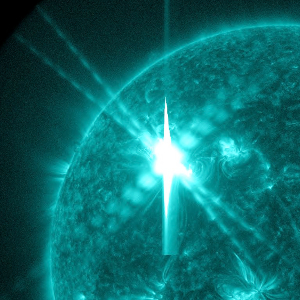Solar Flare, March 6, 2012. Credit: NASA Goddard Space Flight Center, Wikimedia Commons.
–
The search for dark matter continues. This time, scientists are looking for them on the stars and in star flares. If dark matter can form larger structures, asteroid-sized bodies made up of dark matter could fly through space. We don’t really have a chance to detect them, but if a dark planet collided with a star, such as the Sun, it would be much more promising.
From what we know about space and physics, such dark asteroids could whistle through space quite quickly. Anirban Das of the SLAC National Accelerator Laboratory in Menlo Park, California, is betting on this with his colleagues. According to them, a dark planet could fly inside the star at a speed exceeding the speed of sound, creating a cylindrical acoustic shock wave. In this case, the star is thinner than a dark asteroid and would play the role of an acoustic lens. As a result, the shock wave would not scatter around too much, but would amplify at the site of the dark planet. If it reached the surface of the star from the inside, the shock wave would accelerate even more, which would intensify its expression.

Anirban Das. Credit: A. Das.
–
These processes should be sufficient to cause X-rays as well as UV radiation, the afterglow of which would extend to the visible area of the radiation. We should be able to observe something like that. The researchers estimated the density of dark matter in the 47 Tuc cluster and calculated that during the week of observations, the Hubble Space Telescope could detect such a flash. They analyzed previous observations of the cluster in question and found nothing. But the chances were not great.
Observations of future space UV telescopes are said to be more promising. In this case, the researchers propose to focus on the nearby orange dwarfs of spectral class K. If dark asteroids exist and behave as Das et al. they assume their flashes should be captured by UV telescopes.
Our Sun could also be the target of dark planets. If they really fly through space, about one small dark planet should hit the Sun a year. It can even be said that the evidence, ie solar flares, can already be seen many times in the observations of our life-giving star.

Logo. Kredit: SLAC.
–
But of course there is a catch. Leaving aside the assumption that in such a case, dark matter should interact with ordinary matter not only through gravity, the manifestations of dark planet intervention would, if they exist, be very similar to standard solar flares, which are typically related to sunspots. This is, of course, annoying. The difference between dark asteroid eruptions and conventional solar eruptions would be apparent practically only in how the eruption spectrum of the eruption “cools” from the X-ray region to the ultraviolet, visible and infrared regions.
This would mean that ordinary observations of the Sun or other stars are not enough. Immediately after the eruption was detected, it would be necessary to target a number of high-performance devices and examine the flash radiation for a longer period of time, in a large range of the electromagnetic radiation spectrum. This is the only way we could distinguish an eruption after being hit by a dark planet from a normal solar eruption. It sounds interesting, even if the chances of success are not great. Deliberately, if we find dark matter in eruptions on the Sun.
Literature
Physical Review Letters 128: 021101.
–


